|
Have a safe day!
Friday, Sept. 19
1 p.m.
Joint Experimental-Theoretical Physics Seminar (NOTE TIME) - One West
Speaker: Fabrizio Palla, INFN Pisa and CERN
Title: The Rare Decay of Bs to μμ at CMS
3:30 p.m.
DIRECTOR'S COFFEE BREAK - 2nd Flr X-Over
Monday, Sept. 22
2 p.m.
Particle Astrophysics Seminar - Curia II
Speaker: Marilena Loverde, University of Chicago
Title: Testing Neutrino Properties with Large-Scale Structure
3:30 p.m.
DIRECTOR'S COFFEE BREAK - 2nd Flr X-Over
4 p.m.
All Experimenters' Meeting
Special Topic: LArIAT
Visit the labwide calendar to view Fermilab events
|
|
Friday, Sept. 19
- Breakfast: French bistro breakfast
- Breakfast: chorizo and egg burrito
- Carolina pulled pork sandwich
- Chicken vincenza with pasta
- Vegetarian eggplant lasagna
- Cuban panino
- Breakfast-for-lunch omelet bar
- New England clam chowder
- Texas-style chili
- Assorted pizza by the slice
Wilson Hall Cafe menu
|
|
Friday, Sept. 19
Dinner
Closed
Wednesday, Sept. 24
Lunch
- Pan-fried catfish
- Southern style collard greens
- Black eyed peas
- Cornbread
- Sweet potato pie
Chez Leon menu
Call x3524 to make your reservation.
|
|
National Lab Day highlights
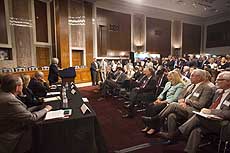 |
| Secretary of Energy Ernest Moniz, at podium, hosted National Lab Day on Tuesday in the U.S. Senate Office Building in Washington, D.C. To his right is a panel of experts who discussed how the labs can be at the forefront of research. Panel, from left: Clark Gellings, fellow at Electric Power Research Institute; Harold Varmus, director of the National Cancer Institute; Jennifer Rumsey, vice president of engineering at Cummins; Norm Augustine, former CEO and chair of Lockheed Martin. Photo: U.S. Department of Energy |
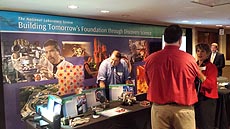 |
| The National Lab Day featured exhibit areas related to scientific discovery, energy, manufacturing, high-performance computing and national security. The discovery science exhibit highlighted DOE's network of scientific user facilities and the unique capabilities available for industry and other researchers. The exhibit provided examples of groundbreaking advancements, including the tools researchers use to search for dark energy, dark matter and the Higgs boson particle. Photo: Kurt Riesselmann, Office of Communication |
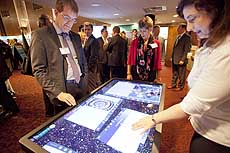 |
| One of the highlights of the discovery science exhibit was a multitouch computer table. It allowed attendees to explore photo galleries and watch videos about the research that national laboratories conduct to discover how the universe works. Fermilab Deputy Director Joe Lykken was part of the exhibit staff on hand to answer questions. Photo: U.S. Department of Energy |
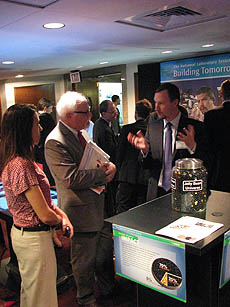 |
| The Jellybean Universe, on display at National Lab Day, shows how dark matter and dark energy account for most of the matter and energy in the universe. Fermilab COO Tim Meyer explains to Lab Day attendees how the national labs try to learn more about the dark universe. Photo: Kurt Riesselmann, Office of Communication |
On Tuesday, Secretary of Energy Ernest Moniz held National Lab Day in the U.S. Senate Office Building in Washington, D.C. The event highlighted research projects from across the national laboratory system. The 17 DOE laboratories provide essential capabilities for nearly 30,000 university and industrial researchers and advance technology frontiers, such as high-performance computing and advanced manufacturing.
At the event Senators Dick Durbin (D-Illinois) and Jim Risch (R-Idaho) formally launched the Senate National Laboratory Caucus, which aims to increase awareness of the reach of the national labs as leaders in developing new breakthrough technologies and discoveries. (The U.S. House of Representatives already has a similar caucus.) Senator Durbin said, "By working together across the aisle, we can make certain that U.S. labs — like Illinois' own Argonne and Fermi — continue to build on their successes and remain world leaders in cutting-edge research."
|
Pursuit of dark matter progresses at AMS
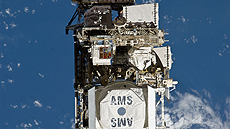 |
| A sign of dark matter could become clear, according to promising results from the Alpha Magnetic Spectrometer experiment. Photo courtesy of NASA |
New results from the Alpha Magnetic Spectrometer experiment show that a possible sign of dark matter is within scientists' reach.
Dark matter is a form of matter that neither emits nor absorbs light. Scientists think it is about five times as prevalent as regular matter, but so far have observed it only indirectly.
The AMS experiment, which is secured to the side of the International Space Station 250 miles above Earth, studies cosmic rays, high-energy particles in space. A small fraction of these particles may have their origin in the collisions of dark matter particles that permeate our galaxy. Thus it may be possible that dark matter can be detected through measurements of cosmic rays.
Read more
—Kathryn Jepsen
|
Senators launch National Laboratory Caucus
From Roll Call, Sept. 16, 2014
A bipartisan group of senators are launching an effort to support the work of the national laboratory system. "DOE's national labs have always been a meeting place for the world's best researchers," said Sen. Richard J. Durbin, D-Ill., "The labs are also an important part of maintaining the United States global competitiveness."
Durbin spoke on Capitol Hill, where directors of the various labs gathered to showcase advancement in research on nuclear reactors, super computers and energy efficiency.
"The caucus is going to serve as a forum to discuss policy and funding issues that confront the national lab system," Durbin said.
Read more
|
National Lab Day: How the national labs keep moving America forward
From energy.gov, Sept. 17, 2014
Do you love science? The Department of Energy does. In fact, the Department is the single largest funder of basic research in the physical sciences in the nation. This research spans the Energy Department's 17 National Labs.
The National Labs are a national treasure. They perform groundbreaking scientific research — from game-changing advancements in solar energy to supercomputer simulations of fossil fuel technologies to "invisible" breakthroughs that affect our daily lives. Some of these advancements were on display at National Lab Day, held yesterday on Capitol Hill.
Read more
|
|
Three ways to be invisible
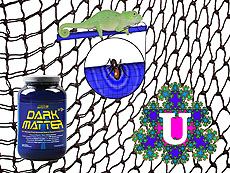 |
| A recent CMS study cast a wide net and put limits on three theories of physics beyond the Standard Model: dark matter, extra dimensions and unparticles. |
There is a common misconception that the LHC was built only to search for the Higgs boson. It is intended to answer many different questions about subatomic particles and the nature of our universe, so the collision data are reused by thousands of scientists, each studying their own favorite questions. Usually, a single analysis only answers one question, but recently, one CMS analysis addressed three different new physics: dark matter, extra dimensions and unparticles.
The study focused on proton collisions that resulted in a single jet of particles and nothing else. This can only happen if some of the collision products are invisible — for instance, one proton may emit a jet before collision and the collision itself produces only invisible particles. The jet is needed to be sure that a collision took place, but the real interest is in the invisible part.
Sometimes, the reason that nothing else was seen in the detector is mundane. Particles may be lost because their trajectories missed the active area of the detector or a component of the detector was malfunctioning during the event. More often, the reason is due to known physics: 20 percent of Z bosons decay into invisible neutrinos. If there were an excess of invisible events, more than predicted by the Standard Model, these extra events would be evidence of new phenomena.
The classic scenario involving invisible particles is dark matter. Dark matter has been observed through its gravitational effects on galaxies and the expansion of the universe, but it has never been detected in the laboratory. Speculations about the nature of dark matter abound, but it will remain mysterious until its properties can be studied experimentally.
Another way to get invisible particles is through extra dimensions. If our universe has more than three spatial dimensions (with only femtometers of "breathing room" in the other dimensions), then the LHC could produce gravitons that spin around the extra dimensions. Gravitons interact very weakly with ordinary matter, so they would appear to be invisible.
A third possibility is that there is a new form of matter that isn't made of indivisible particles. These so-called unparticles can be produced in batches of 1½ , 2¾ , or any other amount. Unparticles, if they exist, would also interact weakly with matter.
All three scenarios produce something invisible, so if the CMS data had revealed an excess of invisible events, any one of the scenarios could have been responsible. Follow-up studies would have been needed to determine which one it was. As it turned out, however, there was no excess of invisible events, so the measurement constrains all three models at once. Three down in one blow!
LHC scientists are eager to see what the higher collision energy of Run 2 will deliver.
—Jim Pivarski
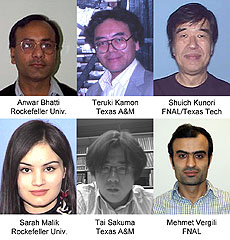 |
| These U.S. scientists contributed to this analysis. |
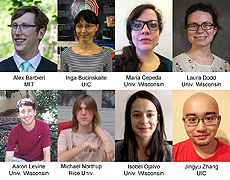 |
| These are some of the U.S. physicists who are developing the Stage 1 upgrade algorithms for the CMS Level 1 calorimeter trigger. The algorithms will significantly improve the performance of the Level 1 trigger system for the upcoming LHC run.
|
|
Goldenrod, meet golden bee
 |
| A bee alights on some tall goldenrod near the Lederman Science Center. Photo: Lauren Biron, Office of Communication |
|
FIRUS system upgrades to affect alarm system sitewide
The FIRUS system will undergo a software upgrade and system testing on Saturday, Sept. 20, from 9 to 11 a.m. This means that the FIRUS system will be offline during this time. It will not notify the Fermilab communication center of active fire-security-utility local alarms. The local building fire alarm systems and other independent emergency systems, including smoke detection, sprinkler systems, flammable gas alarms, pull stations and ODH alarms, will work locally.
In the event of a fire, occupants should follow the building's emergency plan by activating a pull station, evacuating the building and calling x3131 from a Fermilab office phone or 630-840-3131 from a mobile phone.
|
|